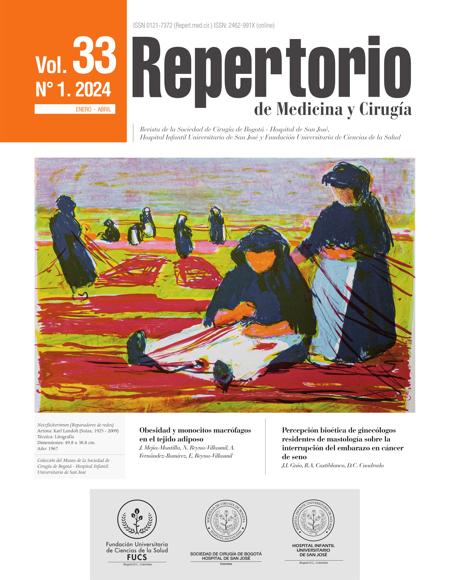Acute ischemic cerebrovascular disease management quality of care following the adoption of the angels initiative
Calidad de atención en el manejo de enfermedad cerebrovascular isquémica aguda posterior a la iniciativa angels
![]()
![]()

Show authors biography
Introduction: cerebrovascular attack (CVA) is common worldwide. One in four people may have a stroke during their lifetime. It is the second leading cause of death and the third leading cause of disability. Thus, it is important to provide integrated care to achieve an impact on quality of life. Objective: to determine ischemic CVA management quality of care among patients seen at the neurology service of the San José and Infantil Universitario de San José hospitals in Bogotá DC, between January 1/2019 and January 1/2020. Methodology: a descriptive, cross-sectional study. The inclusion criteria included patients over 18 years of age diagnosed with ischemic CVA. Information was collected from clinical records. Data was analyzed using descriptive statistics. Results: 411 patients were included; 88.8% had an altered state of consciousness, 26.4% were admitted within the 4.5-hour window for thrombolysis; 11.4% underwent intravenous reperfusion procedures. Door-to-needle time: median was 37.2 minutes versus the national media of 56.5 min according to the ResQ records platform; 72% received anti-platelet therapy and 88.8% received statins. Discussion and conclusions: the establishment of a strict time to care and the implementation of platforms to improve care plans, is essential. Massive education campaigns are required, as well as, institutional improvement plans.
Article visits 1208 | PDF visits 478
Downloads
- Campbell BCV, Khatri P. Stroke. Lancet. 2020;396(10244):129-42. https://doi.org/10.1016/S0140-6736(20)31179-X DOI: https://doi.org/10.1016/S0140-6736(20)31179-X
- Feigin VL, Nguyen G, Cercy K, Johnson CO, Alam T, Parmar PG, et al. Global, Regional, and Country-Specific Lifetime Risks of Stroke, 1990 and 2016. N Engl J Med. 2018;379(25):2429-37. https://doi.org/10.1056/NEJMoa1804492 DOI: https://doi.org/10.1056/NEJMoa1804492
- Herpich F, Rincon F. Management of Acute Ischemic Stroke. Critical Care Medicine. 2020;48(11):1654-1663. https://doi.org/10.1097/CCM.0000000000004597 DOI: https://doi.org/10.1097/CCM.0000000000004597
- Rabinstein A. Update on Treatment of Acute Ischemic Stroke. Continuum (Minneap Minn). 2020;26(2):268-286. https://doi.org/10.1212/CON.0000000000000840 DOI: https://doi.org/10.1212/CON.0000000000000840
- Powers WJ, Rabinstein AA, Ackerson T, Adeoye OM, Bambakidis NC, Becker K, et al. Guidelines for the Early Management of Patients With Acute Ischemic Stroke: 2019 Update to the 2018 Guidelines for the Early Management of Acute Ischemic Stroke: A Guideline for Healthcare Professionals From the American Heart Association/American Stroke Association. Stroke. 2019;50(12):e344-e418. https://doi.org/10.1161/STR.0000000000000211 DOI: https://doi.org/10.1161/STR.0000000000000211
- Mendelson SJ,Prabhakaran S. Diagnosis and Management of Transient Ischemic Attack and Acute Ischemic Stroke: A Review. JAMA 2021 Mar 16;325(11):1088-1098. https://doi.org/10.1001/jama.2020.26867 DOI: https://doi.org/10.1001/jama.2020.26867
- Montaño A, Hanley DF, Hemphill C. Hemorrhagic stroke. Handbook of Clinical Neurology. 2021;176:229-248. https://doi.org/10.1016/B978-0-444-64034-5.00019-5 DOI: https://doi.org/10.1016/B978-0-444-64034-5.00019-5
- Pandian JD, Gall SL, Kate MP, Silva GS, Akinyemi RO, Ovbiagele BI, et al. Prevention of stroke: a global perspective. Lancet. 2018;392(10154):1269-78. https://doi.org/10.1016/S0140-6736(18)31269-8 DOI: https://doi.org/10.1016/S0140-6736(18)31269-8
- Feske S. Ischemic Stroke. The American Journal of Medicine. 2021 Dec;134(12):1457-1464. https://doi.org/10.1016/j.amjmed.2021.07.027 DOI: https://doi.org/10.1016/j.amjmed.2021.07.027
- Powers WJ. Acute Ischemic Stroke. N Engl J Med. 2020;383(3):252-60. https://doi.org/10.1056/NEJMcp1917030 DOI: https://doi.org/10.1056/NEJMcp1917030
- Rabinstein AA. Update on Treatment of Acute Ischemic Stroke. Continuum (Minneap Minn). 2020;26(2):268-86. https://doi.org/10.1212/CON.0000000000000840 DOI: https://doi.org/10.1212/CON.0000000000000840
- Jolugbo P, Ariëns AS. Thrombus Composition and Efficacy of Thrombolysis and Thrombectomy in Acute Ischemic Stroke. Stroke. 2021;52(3):1131-1142. https://doi.org/10.1161/STROKEAHA.120.032810 DOI: https://doi.org/10.1161/STROKEAHA.120.032810
- Kuriakose D, Xiao Z. Pathophysiology and Treatment of Stroke: Present Status and Future Perspectives. Int J Mol Sci. 2020;21(20). https://doi.org/10.3390/ijms21207609 DOI: https://doi.org/10.3390/ijms21207609
- Katan M, Luft A. Global Burden of Stroke. Semin Neurol. 2018;38(2):208-11. https://doi.org/10.1055/s-0038-1649503 DOI: https://doi.org/10.1055/s-0038-1649503
- Gurol ME. Secondary Stroke Prevention in Atrial Fibrillation: New Insights Into an Old Problem. Stroke. 2018;49(6):1315-7. https://doi.org/10.1161/STROKEAHA.118.021262 DOI: https://doi.org/10.1161/STROKEAHA.118.021262
- Campbell BCV, De Silva DA, Macleod MR, Coutts SB, Schwamm LH, Davis SM, et al. Ischaemic stroke. Nat Rev Dis Primers. 2019;5(1):70. https://doi.org/10.1038/s41572-019-01188 DOI: https://doi.org/10.1038/s41572-019-0118-8
- Guo Y, Lane DA, Wang L, Zhang H, Wang H, Zhang W, et al. Mobile Health Technology to Improve Care for Patients With Atrial Fibrillation. J Am Coll Cardiol. 2020;75(13):1523-34. https://doi.org/10.1016/j.jacc.2020.01.052 DOI: https://doi.org/10.1016/j.jacc.2020.01.052
- Moreno E, Rodríguez J, Bayona-Ortiz H. Trombólisis endovenosa como tratamiento del ACV isquémico agudo en Colombia: una revisión sistemática de la literatura. Acta Neurol Colomb. 2019;35(3):156-66. https://doi.org/10.22379/24224022262 DOI: https://doi.org/10.22379/24224022262
- Schwarzbach C J, Eichner F A, Pankert A, et al,. Stroke aftercare : Treatment reality, challenges and future perspectives. Nervenarzt. 2020;91(6):477-483. https://doi.org/10.1007/s00115-020-00909-w DOI: https://doi.org/10.1007/s00115-020-00909-w
- Phipps MS, Cronin CA. Management of acute ischemic stroke. BMJ. 2020;368:l6983. https://doi.org/10.1136/bmj.l6983 DOI: https://doi.org/10.1136/bmj.l6983
- Saini V, Guada L, Yavagal DR. Global Epidemiology of Stroke and Access to Acute Ischemic Stroke Interventions. Neurology. 2021;97(20 Suppl 2):S6-S16. https://doi.org/10.1212/WNL.0000000000012781 DOI: https://doi.org/10.1212/WNL.0000000000012781
- McMeekin P, White P, James MA, Price CI, Flynn D, Ford GA. Estimating the number of UK stroke patients eligible for endovascular thrombectomy. Eur Stroke J. 2017;2(4):319-26. https://doi.org/10.1177/2396987317733343 DOI: https://doi.org/10.1177/2396987317733343
- Marganska V. Stroke Rehabilitation: Therapy Robots and Assistive Devices. Adv Exp Med Biol. 2018;1065:579-587. https://doi.org/10.1007/978-3-319-77932-4_35 DOI: https://doi.org/10.1007/978-3-319-77932-4_35
- Joundi R, Menon B. Thrombus Composition, Imaging, and Outcome Prediction in Acute Ischemic Stroke.Neurology. 2021 Nov 16;97(20 Suppl 2):S68-S78. https://doi.org/10.1212/WNL.0000000000012796 DOI: https://doi.org/10.1212/WNL.0000000000012796
- Kirchhof P, Camm AJ, Goette A, Brandes A, Eckardt L, Elvan A, et al. Early Rhythm-Control Therapy in Patients with Atrial Fibrillation. N Engl J Med. 2020;383(14):1305-16. https://doi.org/10.1056/NEJMoa2019422 DOI: https://doi.org/10.1056/NEJMoa2019422
- Dharmakidari S, Bhattacharya P, Chaturvedi S. Carotid Artery Stenosis: Medical Therapy, Surgery, and Stenting. Curr Neurol Neurosci Rep. 2017;17(10):77. https://doi.org/10.1007/s11910-017-0786-2 DOI: https://doi.org/10.1007/s11910-017-0786-2
- Ibeh C, Elkind SV. Stroke Prevention After Cryptogenic Stroke. Current Cardiology Reports. 2021;23(12):174. https://doi.org/10.1007/s11886-021-01604-1 DOI: https://doi.org/10.1007/s11886-021-01604-1
- Flach C, Muruet W, Wolfe C, et al,. Risk and Secondary Prevention of Stroke Recurrence: A Population-Base Cohort Study. Stroke. 2020;51(8):2435-2444. https://doi.org/10.1161/STROKEAHA.120.028992 DOI: https://doi.org/10.1161/STROKEAHA.120.028992
- Aznaouridis K, Masoura C, Vlachopoulos C, Tousoulis D. Statins in Stroke. Curr Med Chem. 2019;26(33):6174-85. https://doi.org/10.2174/0929867326666190620104539 DOI: https://doi.org/10.2174/0929867326666190620104539
- Caprio FZ, Sorond FA. Cerebrovascular Disease: Primary and Secondary Stroke Prevention. Med Clin North Am. 2019;103(2):295-308. https://doi.org/10.1016/j.mcna.2018.10.001 DOI: https://doi.org/10.1016/j.mcna.2018.10.001












